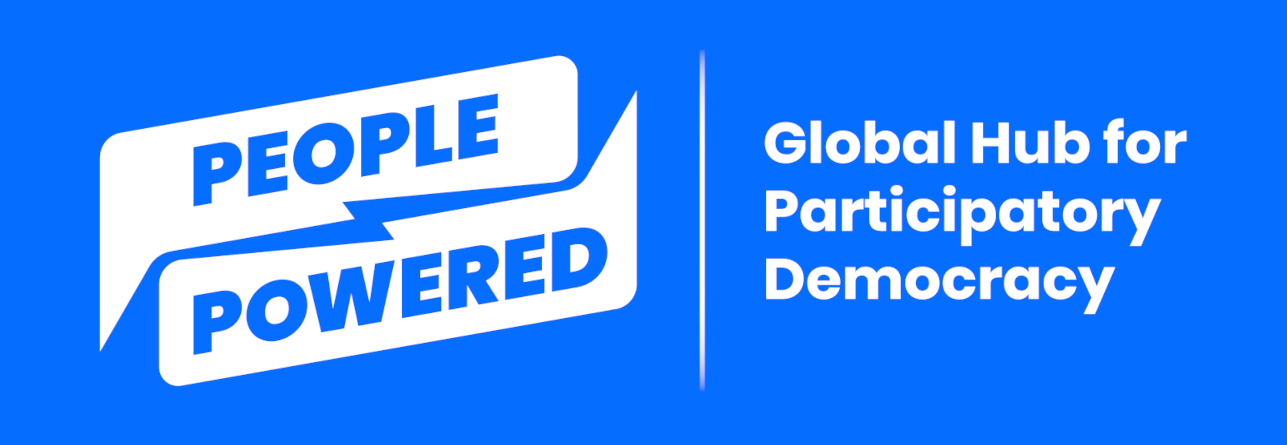Q&A: The Growth of Civic Tech and the New Guide to Digital Participation Platforms
/People Powered released this week the first comprehensive Guide to Digital Participation Platforms, along with a companion “scorecard” of what our team of experts believe are the top 26 products available. Pam Bailey, communications director for People Powered, chatted with Matt Stempeck, principal author of the guide, for a bit of the back story. Matt curates the Civic Tech Field Guide and recently joined Cornell University as technologist in residence to contribute to its growing body of public-interest tech programs.
Pam: You are the principal author of the new People Powered Guide to Digital Participation Platforms. As readers will learn, civic tech—technology that enhances the relationship between people and their government—has become an increasingly crowded field. That’s a very exciting development! What unique value do you think this guide adds to the many resources out there?
Matt: The People Powered guide delves deeper into the institutional realities would-be hosts of these platforms face than any other resource I’m aware of. While someone can always compare a platform’s features (as we do in our matrix), this guide dedicates a lot more attention to the host institution's considerations. For example, how big is their tech team? Which procurement restrictions do they face? Which functions do they need to staff to run a strong participatory process? The Technology Review Committee assembled by People Powered worked with me to anticipate and address as many as possible of the realities of choosing, setting up, and running a participatory process on a digital platform, across a wide variety of contexts. I don’t think that has been done before.
I know from talking to people like Melissa Zisengwe, the member of the Technology Review Committee from the Civic Tech Innovation Network in South Africa, that the sophisticated platforms we feature in our matrix and ratings are not yet in wide use in some regions. Why, and is this guide still valuable to those not ready to use this type of technology?
It does seem that lower-income parts of the world have a dearth of locally developed technology and are also less able to access the advanced platforms developed elsewhere. And I understand why. The cost of hiring and retaining software developers is very expensive, and even using platforms developed by others can be difficult; they require so much energy to train users. Tech support can cost $150 per hour, which, if you're in Jamaica, is just not reasonable. That’s a shame, since these new platforms offer features that can significantly boost equitable, representative participation. For example, Polis can map areas of consensus among residents that are not readily apparent. A number of our interviewees told us that location-sensitive pricing would be a real boon. But in the meantime, they are relying on WhatsApp or Google forms, so they can funnel their energy into community outreach.
Nevertheless, this guide should be very useful to anyone setting up this kind of process using any digital tool—thanks to the comments from all of the advisors recruited by People Powered. It spells out who inside your government needs to be brought into the process, and the necessity of building in a feedback loop. That’s important whether you're using WhatsApp or a platform like Neighborland.
What first led you to personally focus so much of your time and effort on the development and tracking of civic tech?
I’ve always been passionate about social justice and public-interest causes. And my way to contribute is through enabling technology. My formative years were spent at nonprofits in Washington, D.C., focused on issues like climate change and gay marriage, and that usually meant they were under-resourced. Being creative with technology and internet design helps small organizations punch above their weight. In other words, with a relatively small budget, how can you use the internet to get more attention for your cause, reach more people, get more donations, etc.?
Your website, the Civic Tech Field Guide, contains a streamgraph showing the evolution of the field from 1994-2018. It shows very vividly the explosive growth in all types of civic tech. That growth is real evidence of people power, wouldn’t you say?
Absolutely. Civic hackers, volunteer technical workers, developed and grew this field, usually outside of government, often in opposition to government. They built platforms that in an ideal world the government would build. As a side note, what's interesting is that a whole wave of those people who started outside are now working inside government institutions. Now they're in charge and receiving healthy criticism from those still on the outside. That’s healthy.
Your graph seems to indicate that the field is going through somewhat of a contraction. Is that the case, and if so, why?
We were funded to do the research in 2019 and that's when we took the time to research the dates when all of the platforms, etc. were founded. Since then, I’ve kept up the research, but only as a hobby, so there's less data. Thus, we can’t necessarily conclude there’s been a contraction. Anecdotally, however, people in the field say they feel like there has been.
Why? Well, COVID is part of it. So is the intensifying equity discussion. In-person activity connection is critical to public participation, even when technology is available. Some people just aren't online. Others are, but don't feel comfortable telling government what to do when they’re online. It’s a question about who feels comfortable using digital tools to push for government or institutional change. Unfortunately, the answer is often older, rich, white men (“male, pale, and stale” in civic tech humor). We’ve built some great digital participation platforms, but we’re starting to ask ourselves, who are these platforms actually helping?
To counter that, it's important to also invest in in-person workshops, in neighborhoods that aren't as connected and don't participate online as much. And COVID has made that very difficult.
“It’s important to also invest in in-person workshops, in neighborhoods that aren’t as connected and don’t participate online as much. And COVID has made that very difficult.”
So, what you’re saying is that we all need to remember that technology is just a means to an end, not an end in itself.
That’s exactly right. An example: Almost all of these digital participation platforms require users to provide an email address to sign up. But most of the people we interviewed outside of the wealthy regions told us that the constituents they work with don't have email addresses. Or, if they do, they don’t know how to use it or they want to reserve it for family members. That means requiring an email address to set up a user account excludes a bunch of people.
Some of these digital-participation platforms try to address this issue with features that support offline meetings–for example, by allowing hosts to enter minutes from offline meetings and phone calls or making it possible for people to call in to share their opinions. But that's more the exception than the rule.
I’m wondering if political agendas have also tainted the use of civic tech in some cases. In the United States, for example, a lot of people seem to have lost trust in technology after the news broke that a British data analytics company was gathering personal information from Facebook users and feeding it to right-wing political operatives. To what extent has misuse of user data by big-tech firms and governments affected the growth of people-powered civic tech?
That’s been a very important dynamic. After all, there's a host organization or government institution running every process. And if they're running the process, they can configure the platform, frame the questions, and decide what happens with the results. However, while public confidence may be suffering, I don’t think political agendas have polluted outcomes to a significant degree. I conducted some research for the OECD (Organisation for Economic Cooperation and Development) in which I asked some platform developers if their clients were coming to them looking to justify pre-existing decisions, and they genuinely said they didn’t think this was happening. It's just so much extra hassle and expense and time to run a participation process. If governments wanted to manufacture results, there's easier ways than engaging thousands of people.
“That said: Any time you’re talking about public decision making that affects everybody, it’s going to get into power and politics. It’d be naive to think it won’t.”
What about the growing concern about “big tech” like Facebook?
The corrupting influence of big tech and big data is indeed another issue. When a lot of us got into this field, we thought we were using data science for social good. And then some people, including my graduate advisor, started cautioning that some civic tech activities are exploitative. For example, collecting cell phone data from people in Cote d'Ivoire, including their locations, without their consent might not be how we want to do social good. Those arguments have gained a lot of steam in recent years. We're trying to use all these Silicon Valley-style techniques in the interest of the public good, but you can debate whether the wrong means produce the right end.
On the other hand, these well-resourced and thus widely used commercial platforms can be harnessed for good ends as well. Just the ability to connect 2 or 3 billion humans on the same platform is amazing. Yes, it comes with huge costs, but also huge benefits.
For example, public-engagement features can be built into commercial platforms like WhatsApp and Facebook. When I worked in Hillary Clinton’s presidential campaign in 2016, I was surprised to discover that there was no central way to inform people how to find their polling places. Every state, even every county, does it differently. But then Google and the Pew Charitable Trusts worked together to create a centralized dataset; now, Americans can ask Google, “where do I vote?” And the answer comes up.
In the concluding section of our Guide to Digital Participation Platforms, you talk about emerging technology to watch. Is there a particular trend that particularly excites, or scares, you?
One trend that's sort of a double-edged sword is AI (artificial intelligence). Optimistically, AI could make it much easier to read comments from thousands of people and summarize what they're saying. But pessimistically, AI has also enabled “astroturf” groups to populate a platform with what seems like authentic participants and pollute the whole process. (Astroturfing is the practice of masking the authors of a message to make it appear as though they originate from grassroots participants.) AI can even generate authentic-sounding audio and video that isn't real.
We’ll have to keep developing approaches to counter that, like verifying a participant’s address, while allowing them to remain anonymous.
What would you like to see happen with the People Powered digital platform guide and ratings going forward?
Keeping the guide up to date will be important. I’d also love to see more of a crowd-sourcing approach used when the ratings are updated, so that actual users can say what’s best. And since people in lower-resource countries correctly observe that community engagement is most important, no matter what technology is used, additional research into what’s working would be really interesting.







